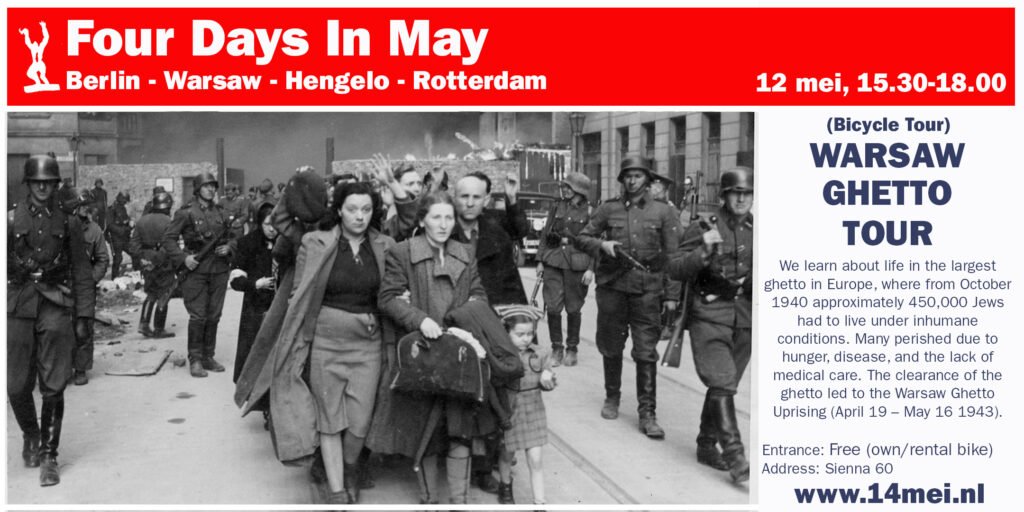Berlin | Warsaw | Hengelo | Rotterdam | Festival Guide

13.00 – 15.00 ![]() |
| ![]() (Museum) Visit Black Monday exhibition at Warsaw Uprise Museum
(Museum) Visit Black Monday exhibition at Warsaw Uprise Museum
+ Anti Bombing Treaty
Muzeum Powstania Warszawskiego, Grzybowska 79
Join us on an unforgettable journey through Warsaw’s storied past. Today, we will explore the Warsaw Uprising Museum and uncover the legacy of defiance that has shaped a nation. Discover how the heroic Warsaw Ghetto Uprising (April 19 – May 16, 1943) sparked Poland’s Home Army into launching an audacious 63-day rebellion against German occupation—a monumental struggle in 1944, and the largest resistance action in Nazi-occupied Europe, as Poles fought fiercely for freedom from both German and Soviet domination. We will also delve into the spirit of a proud nation that, despite more than a century of foreign rule, refused to surrender in the face of overwhelming adversity. Experience the poignant history of the Black Monday air attack on September 25—a relentless 10-hour onslaught from 8:00 to 18:00 that left an enduring mark on the city’s memory. After our museum tour, at 15:00 we will unveil the Polish draft of the world’s first Anti-Bombing Treaty—a bold step forward and a resounding call to halt the devastation of aerial warfare. Stop Bombing Now!

15.30 – 18.00 ![]() |
| ![]() (Museum) Warsaw Ghetto
(Museum) Warsaw Ghetto
Muzeum Powstania Warszawskiego, Grzybowska 79 / Bersohn and Bauman Children’s Hospital, Sienna 60
From Warsaw Uprise Museum we cycle to the former Bersohn and Bauman Children’s Hospital for the official start of our profound bicycle tour tracing the remnants of Europe’s largest ghetto. Established in October 1940, this ghetto confined approximately 450,000 Jews under brutal and inhumane conditions, where hunger, disease, and the scarcity of medical care claimed many lives. By 1942, deportations to the newly constructed extermination camps had begun, setting in motion a devastating chain of events. The eventual clearance of the ghetto sparked the Warsaw Ghetto Uprising (19 April – 16 May 1943), the first major urban rebellion against Nazi occupation. The Warsaw Ghetto bicycle tour will end at the POLIN Museum of the History of Polish Jews (Polish: Muzeum Historii Żydów Polskich). POLIN is a museum on the site of the former Warsaw Ghetto. The Hebrew word Polin in the museum’s English name means either “Poland” or “rest here” and relates to a legend about the arrival of the first Jews to Poland.

20.00 – 21.00 ![]() |
| ![]() (Lecture) Konrad Swinarski
(Lecture) Konrad Swinarski
Adam Mickiewicz Museum of Literature, Rynek Starego Miasta 20
At the Museum Literatury, theatre expert Michał Smolis—whose work with the Theatre Institute and the monthly magazine Teatr enriches our understanding of the stage—invites us to explore the fascinating transformation of Konrad Swinarski (July 4, 1929 – August 19, 1975). Once Brecht’s assistant, Swinarski evolved into one of the most innovative and celebrated figures in Polish theatre history, his influence undiminished even 50 years after his passing. His visionary artistry has profoundly shaped the work of leading directors such as Krystian Lupa, Jerzy Jarocki, and Krzysztof Warlikowski.

21.00 – 22.00 ![]() |
| ![]() (Open Podium) Open Podium Warsaw
(Open Podium) Open Podium Warsaw
Slovenský inštitút vo Varšave, Krzywe Koło 12/14A
The official program in Warsaw is almost over. But we cannot leave Poland without sharing poems, songs, and words of peace here under the stars as well. We’ll do this at several locations along the ancient city wall, including at the Little Insurgent, the Statue of Wars and Sawa, and the Jan Zachwatowicz Monument. After your words of peace, we’ll listen together to Chopin’s Nocturne in C-sharp minor, Op. posth., before bidding farewell to this magnificent city.